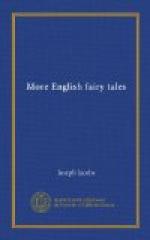LXIV. THE OLD WITCH
Source.—Collected by Mrs. Gomme at Deptford.
Parallels.—I have a dim memory of hearing a similar tale in Australia in 1860. It is clearly parallel with the Grimms’ Frau Holle, where the good girl is rewarded and the bad punished in a similar way. Perrault’s Toads and Diamonds is of the same genus.
LXV. THE THREE WISHES
Source.—Steinberg’s Folk-Lore of Northamptonshire, 1851, but entirely rewritten by Mr. Nutt, who has introduced from other variants one touch at the close—viz., the readiness of the wife to allow her husband to remain disfigured.
Parallels.—Perrault’s Trois Souhaits is the same tale, and Mr. Lang has shown in his edition of Perrault (pp. xlii.-li.) how widely spread is the theme throughout the climes and the ages. I do not, however, understand him to grant that they are all derived from one source—that represented in the Indian Pantschatantra. In my AEsop, i., 140-1, I have pointed out an earlier version in Phaedrus where it occurs (as in the prose versions) as the fable of Mercury and the two Women, one of whom wishes to see her babe when it has a beard; the other, that everything she touches which she would find useful in her profession, may follow her. The babe becomes bearded, and the other woman raising her hand to wipe her eyes finds her nose following her hand—denouement on which the scene closes. M. Bedier, as usual, denies the Indian origin, Les Fabliaux, pp. 177, seq.
Remarks.—I have endeavoured to show, l.c., that the Phaedrine form is ultimately to be derived from India, and there can be little doubt that all the other variants, which are only variations on one idea, and that an absurdly incongruous one, were derived from India in the last resort. The case is strongest for drolls of this kind.
LXVI. THE BURIED MOON
Source.—Mrs. Balfour’s “Legends of the Lincolnshire Cars” in Folk-Lore, ii., somewhat abridged and the dialect removed. The story was derived from a little girl named Bratton, who declared she had heard it from her “grannie.” Mrs. Balfour thinks the girl’s own weird imagination had much to do with framing the details.
Remarks.—The tale is noteworthy as being distinctly mythical in character, and yet collected within the last ten years from one of the English peasantry. The conception of the moon as a beneficent being, the natural enemy of the bogles and other dwellers of the dark, is natural enough, but scarcely occurs, so far as I recollect, in other mythological systems. There is, at any rate, nothing analogous in the Grimms’ treatment of the moon in their Teutonic Mythology, tr. Stallybrass, pp. 701-21.




